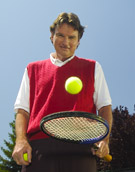A report just released by the PHOENIX CENTER POLICY PAPER SERIES indicates that Internet usage can significantly reduce depression among older adults. Of course, since I’m writing this and you’re reading it, we are in the minority of older adults who are already online (42% of people over 65). Chances are you, like me, regularly use the Internet to manage your money and health, keep up with the news, shop and share stuff.  You may also have joined one of the many social networks and now have a host of online friends. You stay in touch with distant family and friends, sending photos and your favorite You Tube videos. For me, all of this now seems as natural as breathing and I have to remind myself how relatively new the marvelous Internet is. But I didn’t know that I was also keeping myself — and the economy — healthy by doing all these things until I came across this report.
Here are some interesting facts about depression and the older population:
- latelife depression affects about six million Americans age 65 and older
- depression is estimated to cost the United States about $100 billion
- included in this figure is direct medical cost (31%) and latelife suicide (7%)
Here’s an excerpt of the the abstract:
The American Recovery and Reinvestment Act of 2009 directs over $7 billion to expand broadband Internet availability and adoption in the United States. One target of such funding is the elderly population, a group of Americans for which broadband adoption is relatively low. An interesting question is what benefits do such efforts
afford? We employ a dataset of over 7,000 elderly retired persons to evaluate the role of Internet use on mental well-being…using the eight-point depression scale developed by the Center for Epidemiologic Studies (CES-D)…All procedures indicate a positive contribution of Internet use to mental well-being of elderly Americans, and estimates indicate that Internet use leads to about a 20% reduction in depression classification.
On the chance that Pseudo-R2 Analysis of Matching Algorithms are your thing, the full report is available in a pdf file, see link in opening line.
In the meantime, do your patriotic duty. Surf on! And invite the Internet holdouts among your buddies to jump in. The water’s fine.
